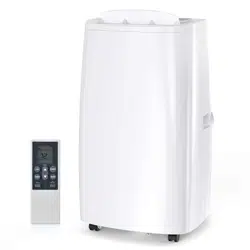Loading ...
Loading ...

2
Disconnect power before cleaning.
NOTE: Turning off the power by pressing the Power button does NOT disconnect the appliance from the power
supply.
Do not install or use the air conditioner in any area where the atmosphere contains combustible gases or where the
atmosphere is contaminated. Avoid any chemicals coming in contact with your air conditioner.
Do not store anything directly on top of the air conditioner.
The appliance can be used by children aged 8 years and above and persons with reduced physical, sensory or mental
capabilities if they have been given supervision or instruction concerning the use of the appliance in a safe way and understand
the hazards involved. Children shall not play with the appliance. Cleaning and maintenance shall not be made by children
without supervision.
This appliance is not intended for people(including children)with reduced physical, sensory or mental capabilities, or
lack of experience and knowledge, unless they have been given supervision or instruction concerning the use of the
appliance by a person responsible for their safety. Children should be supervised to ensure that they do not play with the
appliance.
Use two or more people to move and install the air conditioner.
Never operate the air conditioner without the filters in place.
Do not use the air conditioner near a bathtub, shower or wash basin, or other wet areas.
Do not use means to accelerate the defrosting process or to clean, other than those recommended by the manufacturer.
The appliance shall be stored in a room without continuously operating ignition sources (for example: open flames, an
operating gas appliance, or an operating electric heater. Do not pierce or burn.
Be aware that refrigerants may not contain an odor.
the maximum refrigerant charge amount: APH10CE-14.82Oz
the maximum refrigerant charge amount: APH10CH-14.82Oz
The appliance shall be stored so as to prevent mechanical damage from occurring.
Any person who is involved with working on or breaking into a refrigerant circuit should hold a current valid certificate
from an industry-accredited assessment authority, which authorizes their competence to handle refrigerants safely in
accordance with an industry-recognized assessment specification. Servicing shall only be performed as recommended by
the equipment manufacturer. Maintenance and repair requiring the assistance of other skilled personnel shall be carried out
under the supervision of the person competent in the use of flammable refrigerants.
Prior to beginning work on systems containing flammable refrigerants, safety checks are necessary to ensure that the risk of
ignition is minimized. Work shall be undertaken under a controlled procedure so as to minimize the risk of a flammable gas
or vapor being present while the work is being performed. All maintenance staff and others working in the local area shall
be instructed on the nature of the work being carried out. Work in confined spaces shall be avoided. The area around the
workspace shall be sectioned off. Ensure that the conditions within the area have been made safe by control of flammable
material.
The area shall be checked with an appropriate refrigerant detector prior to and during work, to ensure the technician is
aware of potentially flammable atmospheres. Ensure that the leak detection equipment being used is suitable for use with
flammable refrigerants, i.e. no sparking, adequately sealed, or intrinsically safe.
If any hot work is to be conducted on the refrigeration equipment or any associated parts, appropriate fire extinguishing
equipment shall be available to hand. Have a dry powder or CO² fire extinguisher adjacent to the charging area.
No person carrying out work in relation to a refrigeration system that involves exposing any pipe work that contains or has
contained flammable refrigerant shall use any sources of ignition in such a manner that it may lead to the risk of fire or
explosion. All possible ignition sources, including cigarette smoking, should be kept sufficiently far away from the site of
installation, repair, removal, and disposal, during which flammable refrigerant can possibly be released into the surrounding
space. Prior to work taking place, the area around the equipment is to be surveyed to make sure that there are no flammable
hazards or ignition risks. “No Smoking” signs shall be displayed.
Ensure that the area is in the open or that it is adequately ventilated before breaking into the system or conducting any hot
work. A degree of ventilation shall continue during the period that the work is carried out. The ventilation should safely
disperse any released refrigerant and preferably expel it externally into the atmosphere.
Do not apply any permanent inductive or capacitance loads to the circuit without ensuring that this will not exceed the
permissible voltage and current permitted for the equipment in use. Intrinsically safe components are the only types that can
be worked on while in the presence of a flammable atmosphere. The test apparatus shall be at the correct rating. Replace
components only with parts specified by the manufacturer. Other parts may result in the ignition of refrigerant in the
atmosphere from a leak.
Check that cabling will not be subject to wear, corrosion, excessive pressure, vibration, sharp edges, or any other adverse
environmental effects. The check shall also take into account the effects of aging or continual vibration from sources such
as compressors or fans.
Under no circumstances shall potential sources of ignition be used in the search for or detection of refrigerant leaks. A
halide torch (or any other detector using a naked flame) shall not be used.
Loading ...
Loading ...
Loading ...
